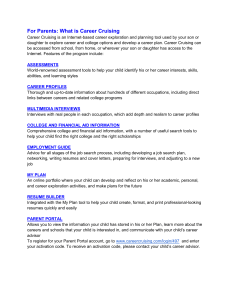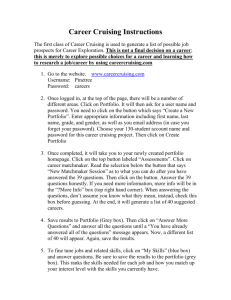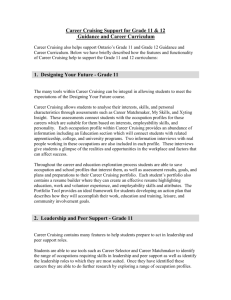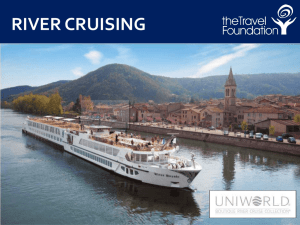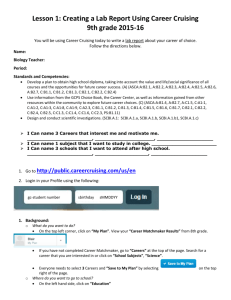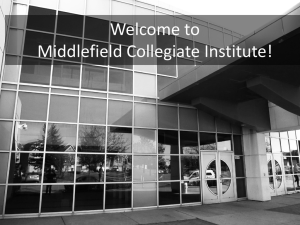Career Studies- Grade 10
advertisement
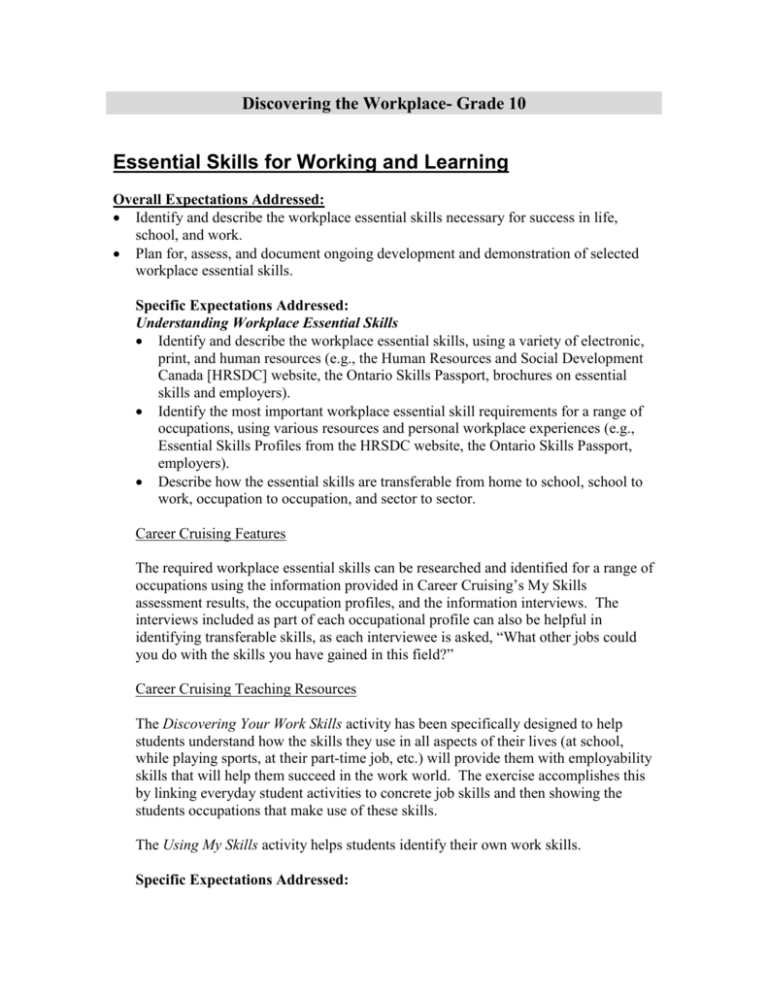
Discovering the Workplace- Grade 10 Essential Skills for Working and Learning Overall Expectations Addressed: Identify and describe the workplace essential skills necessary for success in life, school, and work. Plan for, assess, and document ongoing development and demonstration of selected workplace essential skills. Specific Expectations Addressed: Understanding Workplace Essential Skills Identify and describe the workplace essential skills, using a variety of electronic, print, and human resources (e.g., the Human Resources and Social Development Canada [HRSDC] website, the Ontario Skills Passport, brochures on essential skills and employers). Identify the most important workplace essential skill requirements for a range of occupations, using various resources and personal workplace experiences (e.g., Essential Skills Profiles from the HRSDC website, the Ontario Skills Passport, employers). Describe how the essential skills are transferable from home to school, school to work, occupation to occupation, and sector to sector. Career Cruising Features The required workplace essential skills can be researched and identified for a range of occupations using the information provided in Career Cruising’s My Skills assessment results, the occupation profiles, and the information interviews. The interviews included as part of each occupational profile can also be helpful in identifying transferable skills, as each interviewee is asked, “What other jobs could you do with the skills you have gained in this field?” Career Cruising Teaching Resources The Discovering Your Work Skills activity has been specifically designed to help students understand how the skills they use in all aspects of their lives (at school, while playing sports, at their part-time job, etc.) will provide them with employability skills that will help them succeed in the work world. The exercise accomplishes this by linking everyday student activities to concrete job skills and then showing the students occupations that make use of these skills. The Using My Skills activity helps students identify their own work skills. Specific Expectations Addressed: Developing Workplace Essential Skills Document development of selected workplace essential skills, including evidence of demonstration of these skills from their Ontario Skills Passport. Career Cruising Features Students are able to plan for and document their development of workplace essential skills using the Career and Life Goals, Plans and Preparations, and Skills and Abilities sections of their Career Cruising portfolio. A student’s Ontario Skills Passport plan can be incorporated into his or her Career Cruising portfolio. If a student has saved his or her OSP plan to Microsoft Word or WordPerfect he or she is able to upload a copy to the Your Files section of the portfolio. A link to the OSP website can also be added to the Your Links section of a student’s Portfolio Homepage. Teachers and counsellors can also add web links to the Portfolio Homepage of any or all of their students through Career Cruising’s administrative tools. Career Cruising Teaching Resources Teachers and counsellors are able to set standards for, view, and manage their students’ portfolio work through Career Cruising’s administrative tools. Personal Management Overall Expectations Addressed: Identify interests, strengths, and needs, and describe how these influence decisions about education and work. Specific Expectations Addressed: Self Knowledge Identify, summarize, and document various aspects of a personal profile (e.g., interests, skills, needs, values) using feedback from others, personal reflection, and information from standardized assessment tools, and explain how this information contributes to the development of goals and plans (e.g., decisions about course selection, part-time work, work experience placements). Describe how learning from experience (e.g., work done in school subjects, volunteer work, part-time jobs) can influence their plans for learning and work. Career Cruising Features We have designed the Career Cruising Portfolio as an ongoing project meant to be reviewed and revised often as students’ interests, strengths, and needs change as they learn from experience. Students are able to document their interests, strengths, and needs by storing their interest-based assessment results, skills and abilities, and awards and certificates received, as well as, any career and life goals, and plans and preparations into their Career Cruising portfolio. In each of these sections the student is able to continuously add comments and thoughts regarding future decisions about education and work. Career Cruising Teaching Resources The Career Portfolio Activities walk students through creating and maintaining the information stored in the portfolio. Teachers and counsellors are able to set standards for, view, and manage their students’ portfolio work through Career Cruising’s administrative tools. Exploration of Opportunities Overall Expectations Addressed: Demonstrate the ability to research information about education and work opportunities, using print, electronic and human resources. Describe opportunities for learning and work, and identify ways to prepare for these opportunities. Demonstrate an understanding of the nature of work and of workplace expectations and issues. Identify, explain, and follow health and safety policies and procedures in school and in workplace settings. Specific Expectations Addressed: Researching Information Use an inquiry process (i.e., formulate and ask questions; gather, organize, interpret, assess, and present information) to locate information about education and work opportunities related to career interests (e.g., school subjects, cooperative education, certification courses, work experience opportunities). Locate information for a range of occupations, using print, electronic, and human resources (e.g., Ontario Prospects, National Occupational Classification, mentors, guidance counsellors). Describe through investigation, learning opportunities (e.g., cooperative education, Ontario Youth Apprenticeship Program, school courses, industry certification, first aid training) that are related to education and career goals, using resources in the school (e.g., guidance counsellors, teachers, the Internet) and in the community (e.g., career centres, local businesses, employment and community support agencies). Report on occupations in selected fields of work, using information gathered from interviews (e.g., by e-mail, in person, by telephone) and experiential learning (e.g., job shadowing, job twinning, simulations, site visits). Career Cruising Features Career Matchmaker allows students to locate information on occupations that match their interests, as well as learn about the related education and training programs for these occupations. The Education and Training section of Career Cruising allows students to research apprenticeship programs, colleges, and universities across Canada which offer the education and training for the occupations that interest them. Career Cruising simplifies the career planning process by providing seamless links between Career Matchmaker, occupation information, and specific education and training opportunities while being able to document the process in an electronic portfolio along the way. The two interviews provided as part of each occupation profile can be very helpful to students preparing to interview a member of their community. Reviewing these interviews beforehand can help student determine what sort of questions will help to gain the best understanding of this person’s occupation or field of work. Career Cruising Teaching Resources There are many activities that involve researching career, education, and work information including Using Career Matchmaker, Your Career Ideas & Career Matchmaker, Exploring Apprenticeship Training, Post-Secondary Research Exercise, Independent Research Projects, and the Career Interview Project. Specific Expectations Addressed: Exploring Learning and Work Opportunities Demonstrate knowledge of a range of occupations (e.g., duties, employment prospects, required knowledge and skills) and of the related education and/or training requirements. Describe the educational opportunities available in school (e.g., specific courses), in the community/workplace (e.g., job shadowing, volunteer work first aid training), or on the Internet (e.g., e-learning, e-cooperative education) that can contribute to the achievement of their goals for learning and work. Describe the characteristics and skills required for self-employment, including entrepreneurship. Describe work-style alternatives (e.g., contract work, job sharing, “flex-time” arrangements, telecommuting) and identify which ones best suit their interests, skills and values. Career Cruising Features The many search tools within Career Cruising allow students to locate information and demonstrate knowledge of a range of occupations (including entrepreneurship and many careers which involve self-employment) as well as learn about the related education and training programs for these occupations. Each occupation profile contains information on the duties, and required knowledge and skills. The two people interviewed for every occupation provide their opinions on employment prospects and job security. A link to Job Futures employment prospect information is also available in the Other Resources section of each occupation profile as well as links to do further research on community or workplace opportunities. The Education and Training section of Career Cruising allows students to research apprenticeship programs, colleges, and universities across Canada that offer the education and training for the range of occupations they choose to explore. Career Cruising provides seamless links between occupation information, and specific education and training opportunities. The two interviews provided as part of each occupation profile can help students gain an understanding of different work style alternatives. Career Cruising Teaching Resources There are several Classroom Activities that involve exploration of learning and work options including School Subjects & Careers, Using Career Matchmaker, Using Career Selector, People, Information, and Things, Career Clusters Research Project, Career Interview Project, Exploring Apprenticeship Training, and Post-Secondary Research Exercise. Specific Expectations Addressed: Understanding the Workplace Identify the attitudes, behaviours, work habits, and skills, including the workplace essential skills, required to obtain and keep a job. Identify various workplace issues(e.g., ethics, confidentiality, harassment, equity, responsible use of technology) and explain how policies and procedures dealing with these issues contribute to a positive and productive work environment. Career Cruising Features Each occupation profile within Career Cruising contains two interviews with people working in the occupation. Questions such as “What personal characteristics are required for someone to be successful in your job?” give students insight into the attitudes, behaviours, work habits, and skills required to obtain and keep a job. Questions such as “What are the biggest challenges in your job?” help students learn about possible workplace issues. Each interview also contains a Dislikes section where interviewees are asked to discuss and elaborate on anything they dislike about their job. Career Cruising Teaching Resources The Career Interview Project helps to familiarize students with the content of the informational career interviews. Specific Expectations Addressed: Demonstrating Health and Safety Awareness Identify health and safety hazards in the school and in the workplace. Career Cruising Features The Working Conditions section of each occupation profile informs students of possible health and safety hazards in the workplace. Preparations for Transitions and Change Overall Expectations Addressed: Identify goals and develop plans for learning in school, the community, and the workplace. Apply job-search strategies and tools to find or create opportunities for work and for learning about work. Specific Expectations Addressed: Planning for Learning and Work Identify career goals and explain how these relate to interests, skills, and values. Describe the career-planning process (i.e., determine personal interests and attributes; investigate education and career opportunities in the school, community, and workplace; decide which opportunities to select; plan the transition) and use it to develop goals and plans for learning and work. Career Cruising Features Building a complete Career Cruising portfolio over time simplifies the process of identifying goals and developing plans for learning in the school, community, and the workplace. Students are able to use their portfolio throughout their secondary education to continuously review and revise assessment results, update skills and attributes, and record careers and education and training options of interest. Keeping this information in one easy-to-access tool helps students identify their career goals and keep a record of their career planning process. Any short term and long term goals can also be recorded and continuously updated through the Portfolio Tool. Career Cruising Teaching Resources Teachers and counsellors are able to set standards for, view, and manage their students’ portfolio work through Career Cruising’s administrative tools. Specific Expectations Addressed: Searching for Work Document evidence of the knowledge, skills (including workplace essential skills), and work habits acquired in school, the community, or the workplace, using the Ontario Skills Passport and other tracking tools. Create effective job-search tools (e.g., resume, cover letter, portfolio) that reflect their knowledge, strengths, experience, skills (including workplace essential skills), and work habits, using a word-processing program and appropriate vocabulary and conventions, for an experiential learning, volunteer, or work opportunity. Career Cruising Features The Career Cruising portfolio allows students to continuously document new skills developed in school, the community, and the workplace. A student’s Ontario Skills Passport plan can be incorporated into his or her Career Cruising portfolio. If a student has saved his or her OSP plan to Microsoft Word or WordPerfect he or she is able to upload a copy to the Your Files section of the portfolio. A link to the OSP website can also be added to the Your Links section of a student’s Portfolio Homepage. Teachers and counsellors can also add web links to the Portfolio Homepage of any or all of their students through Career Cruising’s administrative tools. The Career Cruising Resume Builder uses information stored in the portfolio such as a student’s personal profile, work experience, volunteer experience, awards and certificates, extracurricular activities, and skills and abilities as well as a career objective, education, and references to format an effective resume that can be exported to Microsoft Word. Final drafts, cover letters, and thank you letters can all be uploaded into the student’s portfolio and stored in the Your Files section. Career Cruising Teaching Resources The Career Portfolio Activities contain a specific Using the Resume Builder activity. Teachers and counsellors are able to set standards for, view and manage their students’ portfolio work and resumes through Career Cruising’s administrative tools.
